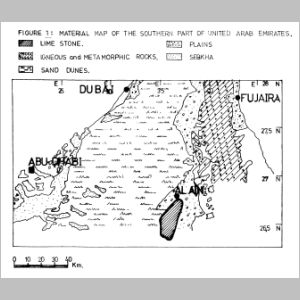Bulletin 10 - March 1980: Movement of Desert Sand on the Al Ain-Dubai Road, UAE
Movement of Desert Sand on the Al Ain-Dubai Road, UAE
By Dr. Adnan B. Al NaqashSummary: Repetition phenomena of desert sand movement as a result of sand storms have been observed during the last two years on the Al Ain-Dubai road. The interaction of the wind with the individual flying sand grains produces a mobile sheet of sand across the motorway. This problem should be considered for the safety of the road user.
Introduction: The observation of tumbling sand has been made on Al Ain-Dubai road during the years 1978 and 1979 where the dunes are accessibly located near the main road. These moving sand carpets are restricted to big dry valleys near the Al Hare area. The sand supply comes from the dune belt that covers an area of triangular shape between Abu Dhabi-Al Ain-Dubai. The source of origin of this sand dune belt is from the Arabian peninsula formation that dominates the dune trends. This sand formation is sometimes referred to as seas of sand in which the solid rock landscape is buried under a thick and extensive blanket of loose sand whose upper parts are built into complex forms. It is lying in a structural offshoot of the sand dunes probably accumulated in a marine environment during later Tertiary times before the shallow littoral sea became land (probably some 60-million years ago).
The petrographic structure of the moving sand is mainly quartz ranging in size from 0.02mm to 2mm in diameter. However, the vast majority of the sand grains have a diameter of between 0.02mm and 0.8mm. For any individual grain the movement is markedly discontinuous and the overall flow is rather slow. Thus we have patches of sand spread over the road.
Recommendations: The moving sand carpet on the Al Ain-Dubai road was restricted to the big dry valley near Al Hare area, that is about 50km north of Al Ain city. The sand, although rapidly sorted out, thus tends to be transported only limited distances and the bulk of it remains within the area of the main road. It has a marked tendency to be piled up into widely-built features, sorted in harmony, thus they should be watched and removed always. Meanwhile, the sand dune belts in the nearby area could be fixed with vegetation such as Acacia grass to create a scrub savanna successfully used in similar environments in Australia.
(Dr. Adnan B. Al Naqash lectures in the Geology Department, Al Ain University.)
